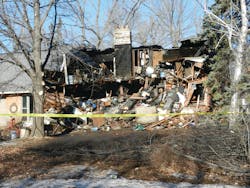“Attack team one to command, heavy contents.” What does this phrase mean to you? It means that the structure they working in is full of belongings, or a “hoarder home.”
With this growing problem becoming popular in reality TV, the fire service must use the bright lights of Hollywood to keep training to fight these types of fires. As the near misses and news stories keep rolling in, we all should discuss what it would be like to fight hoarder home fires. Let’s take a moment to discuss initial size-up and tactics. A 380-degree size-up (adding 20 degrees to the normal 360) will give you 20 more years in the fire service.
Most of today’s officers have been taught to perform a 360-degree walk-around of the building to size-up the situation. As a common practice, doors, windows, smoke and fire conditions are all being accounted for. Now, let’s add another 20 degrees of size-up by looking at the owner’s vehicle. Why would we take the time to look in someone’s vehicle? Well, maybe we shouldn’t look at it on every fire, but when we start to suspect a hoarder condition is involved, the extra few seconds to look into someone’s vehicle could give you a world of information.
Let’s use the example of a first-arriving officer walking around a single-family home. He notices that the windows are blocked, that’s clue number one. What if the officer has to step over large amounts of belongings in the yard? That’s clue number two. Time to take a peek in their car! As you approach the vehicle, you notice that it is loaded down with a large amount of belongings. Bam, that is clue number three. You should be ready to face-off head-to-head with a fire in a hoarder home.
An announcement should be made over the radio, “Units responding to XYZ street...we have a heavy content fire.” This should be a cue and a clue to everyone that this house is under stress before the first droplet of water is applied. Many homes that are loaded with belongings and have structural issues due to the lack of maintenance. As a decision maker in the most important five minutes of a response, the use of your senses and an extra 20 degrees will help. An adjustment on tactics will need to be made when faced with a hoarded home.
Now that we have established that we may be dealing with a hoarded home, let’s attack this monster. To the front door we go. Wait a minute. Is the front door the best way to attack? Well, it may not be. Some people that accumulate a large amount of belongings will have their house narrowed down to small usable spaces and the front rooms may not be ones. Many times the belongings will have taken over the living or family rooms. Some people may have brought so much material into their home that the bedrooms are all that’s left that can be accessed.
When we are making our 380-degree size-up, we should find the best point of entry. I agree that most of us will make this decision as would you, but it will become harder when the loads of belongings begin to reach shoulder or even head height. So how do we handle this? I vote to hit it from the outside and use the lack of airflow to help use a steam approach to fighting this fire. Now you’re probably thinking, “Did he say use a fog nozzle, mess up the thermal balance, not ventilate and use an outside fire flow directed in to combat this problem?” Yes I did.
I understand the discussion of late of using this tactic from both sides. I would never second-guess anyone’s choice in not using this tactic as to the consequences of pushing fire to the unburned portions of the house. I understand and agree, unless it is a hoarded home. These fires, where you can’t get near the seat of the fire, can be a huge challenge with a needed change in tactics. The sheer amount of contents will not allow you to gain access to the seat. So instead of placing our people into a riskier environment, lets darken it down from the outside, wait for the smoke to change colors, vent and then go in to finish it off. This will allow time for added personnel to arrive, make a ventilation strategy, choose the best way to dig in to the structure and allow for a larger RIT team to be available.
Hoarded homes are not conventional house fires. They are tactically challenging, non-typical fires that require you to think and attack in different ways. I totally agree that we need to make entry into normally furnished buildings with a reserve amount of aggression and put the seat of the fire out. But we need to also remember that in these conditions of reduced pathways, that may not be possible. We should not put our people into spots where flashover will happen sooner, entanglement hazards are everywhere and an attic space full of stuff is just waiting to fall on their heads. Let’s use an outstanding firefighter to stand outside and darken it down first. If we spread fire, it was most likely head that way anyway because the fire spreads faster in hoarded homes.
In closing, I would like a moment to review what’s in this article. Hoarded homes that catch on fire are not bread-and butter-fires. They are complicated monsters with increased flashover risks, huge amounts of fuel loads and a building collapse waiting to happen at any moment. We need to take the time to size them up and call them out. “IC, this is Attack Team 1...we are experiencing heavy contents.” When these words go out, your brain should be going into a new mode. A mode that changes from the common way of attacking a fire to using some approaches that will not put our people into an extremely more dangerous fire that will kill us faster. Remember that when you suspect a hoarder home on fire you should “add 20 degrees” more to your size-up to keep your people safe.







